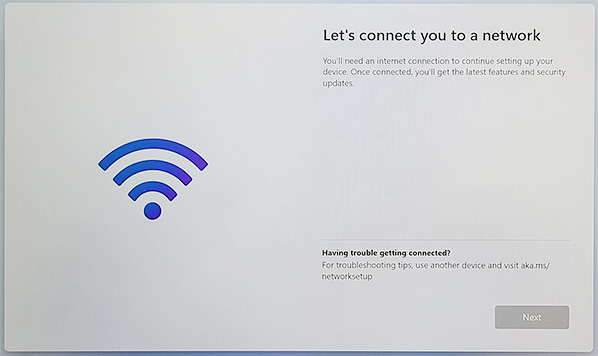In this issue LANGALIST: Win11 Home never completely lets go Additional articles in the PLUS issue PUBLIC DEFENDER: Bulging batteries in Surface laptops are a growing issue BEST UTILITIES: Freeware Spotlight — CrysalDiskInfo PATCH WATCH: November cleans up October’s mess
LANGALIST Win11 Home never completely lets go
By Fred Langa Even after upgrading to Pro, PCs that start with Windows Home can retain several critical Home limitations that royally foul up future from-scratch reinstalls and upgrades. Win11 (both Home and Pro) also continues to show other serious rough spots and omissions — with drivers, especially — that can turn a simple upgrade into a multi-day nightmare. Read on before you attempt an upgrade, especially if you’re using a Home edition! Still not done after nine installs over five days
At last, both my main PCs are finally running on Win11, sort of. The experience was the opposite of what I had expected. I had anticipated trouble from my older system, a two-to-three-year-old, heavily modified Win10 Pro laptop equipped with a non-OEM SSD, third-party RAM, and many non-OEM peripherals and software. However, it upgraded perfectly on the first try. Smooth as silk! I had expected no trouble from the other system, an almost brand-new Win10 Pro laptop with zero non-OEM modifications, almost no software installed, and no peripherals plugged in. Instead, that upgrade to Win11 failed and failed and failed again, no matter what I tried. Smooth as sandpaper! So far, it’s taken fully nine installs, over five days, before that problematic PC was up and limping along well enough to use at all. But it still has minor weirdnesses and glitchlets, so a tenth attempt is right around the corner. It’s the worst upgrade experience I’ve had with Windows since the days of floppy disk–based installs! But I’m determined to get the new OS running on this hardware, or find out why these installs failed. To spare other Win11 Home-to-Pro upgraders from the same pitfalls I encountered — and am still encountering! — today’s column is a small detour before getting to the “Part 2” information I was expecting to write as a follow-on to last issue’s Wait for Windows 11.1 (AskWoody Plus 2021-11-08). That information will appear in the next column. Win11 Home retains its roots even after a Pro upgrade Some aspects of Win11’s upgrade process revert back to a methodology that Microsoft abandoned (for good reason!) with Windows 7. If you used Windows back then, you may recall that for much of Win7’s life, a full reinstall required going back to the original, first-released setup files and then manually layering in various individual updates plus one or more Service Packs — which were aggregate bundles of updates, each a kind of OS upgrade in itself. So reinstalling Win7 from scratch actually involved several back-to-back, manual reinstalls to get everything fully up to date. It was a cumbersome pain in the butt. But it’s back: Win11 Home upgrades now do much the same thing. Even if you’ve previously and successfully upgraded Win11 Home to Pro, you’ll be forced to start over with your original Win11 Home setup during a full, from-scratch reinstall or upgrade; layer in the Home updates; and only then manually “re-upgrade” back to Pro. That’s at least an inconvenience and can even be a showstopper — it sure was for me! — due to other changes in the way Win11 Home’s Setup works. Let me explain. Once Win11 Home, always Win11 Home My newest laptop (just a few months old) originally shipped with Windows 10 Home — the only option then offered by the OEM. But soon after getting the PC, I paid the extra $100 and upgraded to Win10 Pro via the official upgrade link in the Windows Store. That upgrade went smoothly. All was well, and my PC was happily running Win10 Pro, error-free. When Win11 became available for that PC, I tried — and tried, and tried — to get the upgrade going, as you saw in last week’s column. After the fourth or fifth attempt, I was finally able to get the PC upgraded and limping along, but there was enough uncorrectable residual weirdness to make me nervous. Rather than live with a marginally malfunctioning upgrade, I decided to start fresh with a from-scratch, “bare-metal,” Win11 install. With nothing carried over from the OEM setup, I figured Win11 would have the best-possible chance of getting everything set up properly. I downloaded and ran the Win11 setup via the new Create Windows 11 Installation Media option. Everything started normally. Using Setup’s built-in tools (same as Win10’s), I wiped out all partitions on the SSD to let Win11 set up everything from scratch, with nothing left behind from previous installations. Setup almost immediately stumbles and hangs Setup’s introductory screens ran normally, but before any installation actually began, Win11 hung on the “Let’s connect you to a network” page: it was unable to find any available connection, despite having been online moments earlier. (See Figure 1; it’s a smartphone photo because that’s the only way I could capture the screen.)
I knew that Win11 Home normally requires a network connection to install, but I had legitimately upgraded this PC to Pro, via the Windows store. Silly me: I had thought a legit, handled-entirely-by-Microsoft upgrade to Pro would have updated or annotated the product key stored in the PC’s UEFI. Apparently not. Win11 setup was requiring — and then failing to find — a Home-type connection before proceeding. In Win10, you could work around networking issues during setup by using or creating a local account, a self-contained, PC-based account requiring neither a network connection nor a Microsoft account. But Win11 Home does not permit use of a local account during a full install or reinstall. Without network access, I was stuck. And where were the networks? This PC — same hardware — had been online up to the moment that Setup began. The PC was sitting maybe 10 feet (3 meters) from my Wi-Fi 6 router, which was operating normally. My phone and other PCs could still see the router and showed a strong signal. Plus, I live in an apartment building, and I usually can see dozens of other Wi-Fi SSIDs. But now, suddenly, Win11’s Setup was completely Wi-Fi-blind, and stuck. Jeebus. I rebooted the PC and the router, made sure I hadn’t accidentally put the laptop into Airplane mode or turned off the Wi-Fi, and reran setup. Nothing. Same hang, and no way to get past the network connection screen. Bad default drivers in the Win11 Setup files My guess here is that the Win11 Setup’s driver suite is incomplete and contained no driver capable of using my new laptop’s Wi-Fi subsystem — a plain-vanilla MediaTek Wi-Fi 6 card that works fine in Windows 10 and even in Win11, after installation. But apparently, the generic drivers included in the Win11 Installation files can’t work with that hardware. Why not use a wired connection? Great idea, except that — like many newer laptops — mine doesn’t have an Ethernet port: it’s meant to be Wi-Fi only. Sigh. So, I ordered a simple USB-to-Ethernet dongle, and then continued trying to get the installation finished in the meantime. Were the setup files somehow corrupted? I used a different PC to download and burn a fresh Win11 setup flash drive, booted the malfunctioning laptop with it, and reran Setup. But … nothing. Same hang at the same point. Hmmm. I decided to try rolling back the PC, using a Win10 Pro system image from when everything — including the Wi-Fi — was working properly. It worked fine, and the PC was soon back happily running Win10 Pro. The Wi-Fi connected without trouble. “Missing files” on a brand-new setup? With a fully working Win10 setup as a base, I then tried upgrading to Win11 again, this time using the Upgrade Assistant (just to try a different process). The Upgrade Assistant is an “in situ” option, where a running copy of Windows updates itself. As such, because the Wi-Fi was already running, there was no immediate showstopper problem, and Win11 got itself installed. But again, there was residual weirdness. For example, the PC would not now reliably respond to a shutdown command. Instead, it would shut down — full lights-out — but then immediately turn back on again. I literally could not turn the PC off via software. I had to long-press and hold the physical power button. Seems like another driver issue. And, when I tried to create a new Recovery Drive (so I could quickly get the PC back to the same point), I got an error message stating, “Some required files are missing …” (See Figure 2).
Note that the “missing files” message happened just after an upgrade from a fully working Win10 installation. Win11 either deleted something it shouldn’t have or failed to install something it should have. No way to know which, nor to tell what’s missing. I tried to supply the “missing files” via a Win11 Repair installation. (For info, scroll down to “Use the Startup Repair function” on this Microsoft support page.) Nope. Nothing changed. I ran Microsoft’s recommended DISM+SFC method of verifying system file integrity. Neither tool found any errors. I was getting pretty tired of Win11 by now, so I gave up on that PC, waiting for the USB-to-Ethernet dongle to arrive in a day or two. Instead, I started work on the second, older PC — the one I had expected might well have issues because of its age plus the fact that I’d highly modified the hardware. After making a full system image backup of that PC, I used Windows Upgrade’s “Win11 is ready for your PC …” option and let it do its thing. The upgrade went perfectly; no glitches, nothing missed or bobbled, no weird errors afterwards, no absent functions. Go figure. Here come the patches! I’m writing this column on that second laptop, on which Win11 is running fine. If there are problems, they’re subtle enough that I haven’t encountered them yet. Meanwhile, as the un-upgraded PC awaits its Ethernet dongle, Microsoft, ASUS, and AMD have all been busy releasing updates for Win11 in general and that PC in particular. Best guess: The problems I was having are not at all unique but rather extend to many other PCs as well. As the error reports trickle back to Microsoft and the hardware makers, patches will be forthcoming — in fact, they’re already starting. I’m expecting a minor flood of them. All of which suggests that Win11 isn’t quite finished yet. Early adopters — even on almost brand-new hardware! — may still encounter beta-version-type problems. If you don’t have to upgrade to Win11 right away, it’d probably be smart to wait a while — if not for Win11.1, then certainly for at least several rounds of patches to address the worst incompatibilities. In the next column, you’ll see how the Ethernet-enabled Home upgrade goes; see screen shots of some of the best and worst elements of the new Win11 interface; see several workarounds for common issues; and more. Stay tuned!
Fred Langa has been writing about tech — and, specifically, about personal computing — for as long as there have been PCs. And he is one of the founding members of the original Windows Secrets newsletter. Check out Langa.com for all of Fred’s current projects.
You’re welcome to share! Do you know someone who would benefit from the information in this newsletter? Feel free to forward it to them. And encourage them to subscribe via our online signup form — it’s completely free!
Publisher: AskWoody Tech LLC (sb@askwoody.com); editor: Will Fastie (editor@askwoody.com). Trademarks: Microsoft and Windows are registered trademarks of Microsoft Corporation. AskWoody, Windows Secrets Newsletter, WindowsSecrets.com, WinFind, Windows Gizmos, Security Baseline, Perimeter Scan, Wacky Web Week, the Windows Secrets Logo Design (W, S or road, and Star), and the slogan Everything Microsoft Forgot to Mention all are trademarks and service marks of AskWoody Tech LLC. All other marks are the trademarks or service marks of their respective owners. Your subscription:
Copyright © 2021 AskWoody Tech LLC. All rights reserved. |













